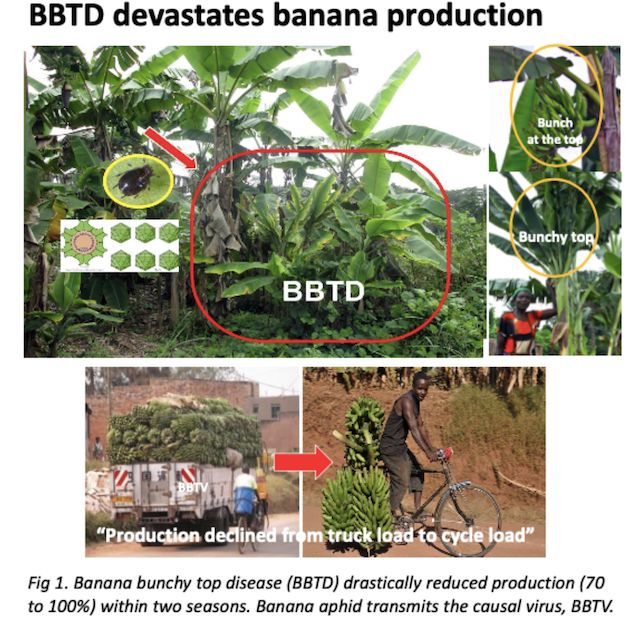KIGALI, Aug 05 (IPS) – A group of scientists involved in finding solutions to minimize the impact of a devastating banana virus in Burundi have developed an Artificial Intelligence (AI) tool for monitoring the disease.
United Nations Food and Agricultural Organization (FAO) research shows that the Banana Bunchy Top Disease (BBTD), caused by the Banana Bunchy Top Virus (BBTV), is endemic in many banana-producing countries in sub-Saharan Africa.
The virus was first reported in the Democratic Republic of Congo (DRC) in the 1950s and has become invasive and spread into 15 countries in sub-Saharan Africa.
The disease has been reported in Angola, Benin, Burundi, Cameroon, Central African Republic, Republic of Congo, DRC, Equatorial Guinea, Gabon, Malawi, Mozambique, Nigeria, Rwanda, South Africa, and Zambia. The latest findings, however, show that BBTD is currently a major threat to banana cultivation and a threat to over 100 million people for whom the banana is a staple food.
The AI development team, led jointly by Dr Guy Blomme and his colleague Dr Michael Gomez Selvaraj from the Alliance of Bioversity and CIAT (ABC), tested the detection of banana plants and their major diseases through aerial images and machine learning methods.
This project aimed to develop an AI-based banana disease and pest detection system using a Deep Convolutional Neural Network (DCNN) to support banana farmers.

While farmers struggle to defend their crops from pests, scientists from ABC have created an easy-to-use tool to detect banana pests and diseases.
The tool, which has proven to provide a 90 percent success in detection in some countries, such as the DRC and Uganda, is an important step towards creating a satellite-powered, globally connected network to control disease and pest outbreaks, say the researchers.
During the testing phase, in collaboration with a team from the national agricultural research organization of Burundi – ISABU, two sites where the banana bunchy top disease is endemic in Cibitoke Province were compared with an area free of the disease in Gitega Province (Central).
Cibitoke Province is BBTD endemic and lies in a frontier zone bordering Rwanda and the Democratic Republic of Congo (DRC).
Performance and validation metrics were also computed to measure the accuracy of different models in automated disease detection methods by applying state-of-the-art deep learning techniques to detect visible banana disease and pest symptoms on di?erent parts of the plant.
Researchers set out the reasons detecting disease in bananas is so vital.
“In East and Central Africa, it is a substantial dietary component, accounting for over 50% of daily total food intake in parts of Uganda and Rwanda.”
Bananas are also the dominant crop in Burundi. The surface area under cultivation is estimated at 200,000 to 300,000 ha, representing 20 to 30% of the agricultural land.
Data from Burundi’s Ministry of Agriculture and Livestock indicate food security and nutrition continue to worsen, with 21 percent of the population food insecure. They say this could be exacerbated by various plant diseases such as BBTD.
While banana is crucial to people’s food security and livelihoods, experts also argue that BBTD could potentially have a devastating economic and social impact on the continent.
“Based on the fact that when BBTD comes in, it is initially a very cryptic disease and does not display spectacular symptoms,” Bonaventure Omondi, a CGIAR researcher who collaborated on this project and who works on related banana diseases and seed systems projects, told IPS in an interview. While it was crucial to stop the disease early, it was also challenging, which is why the AI solution was vital.
Agriculture experts say that the East African Highlands is the zone of secondary diversity of a type of bananas called the AAA-EA types. These bananas are genetically close to the dessert banana types but have been selected for use as beer, cooking, and dessert bananas.
Banana cultivation in Burundi is grouped into three different categories. Banana for beer/wine in which juice is extracted and fermented accounts for around 77 percent of the national production by volume. Fourteen percent of bananas are grown for cooking, and finally, about five percent are dessert bananas which are ripened and directly consumed.
With recent advances in machine learning, researchers were convinced that new disease diagnosis based on automated image recognition was technically feasible.
“Minimizing the effects of disease threats and keeping a matrix mixed landscaped of banana and non-banana canopy is a key step in managing a large number of diseases and pests,” Omondi said.
As an example of how this emerging technology works, researchers focus on data sets depicted on banana crops with disease symptoms and established algorithms to help identify plantations where the disease is present.
Prosper Ntirampeba, a banana grower from Cibitoke Province in north-western Burundi, told IPS that he harvested fewer bunches of bananas in the latest season because of BBTD that spread through his farmlands.
“We have been forced to uproot infected plants since this disease reached our main production area. This resulted in a huge extra cost burden,” he said.
In another case, with the detection of BBTD, agricultural officials under instruction from researchers advised farmers to remove all infected ‘mats’ where several hectares of diseased plants had been destroyed. This is the key to eliminating the disease in Busoni, a remote rural village in Northern Burundi.
Although some farmers often resist uprooting their banana plants, Ntirampeba said it was vital to eliminating the disease.
“The disease is likely threatening livelihoods of most farmers who are dependent on the crop,” he told IPS.
Currently, other novel disease surveillance methods are also being developed by ABC researchers in Burundi, including drone-based surveillance to determine local disease risk and delimit recovery areas.
IPS UN Bureau Report
Follow @IPSNewsUNBureau
Follow IPS News UN Bureau on Instagram
© Inter Press Service (2022) — All Rights ReservedOriginal source: Inter Press Service
Check out our Latest News and Follow us at Facebook
Original Source